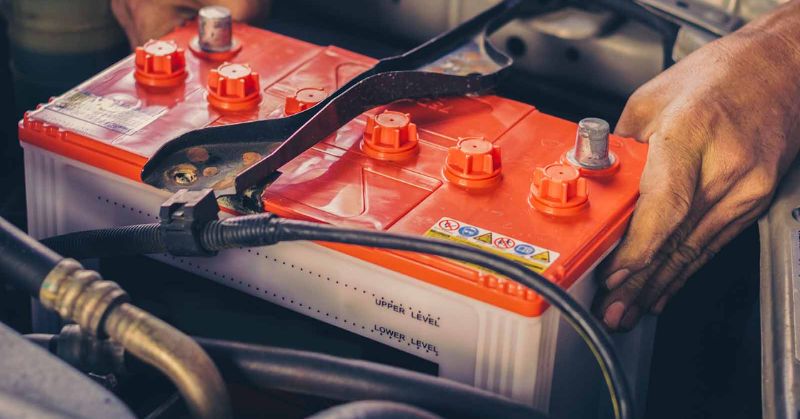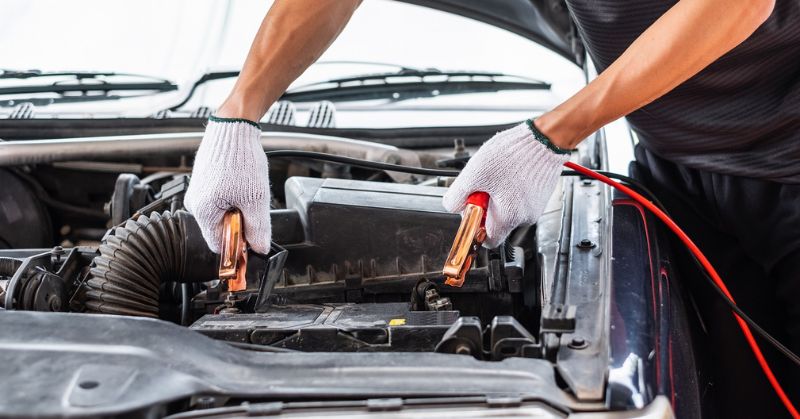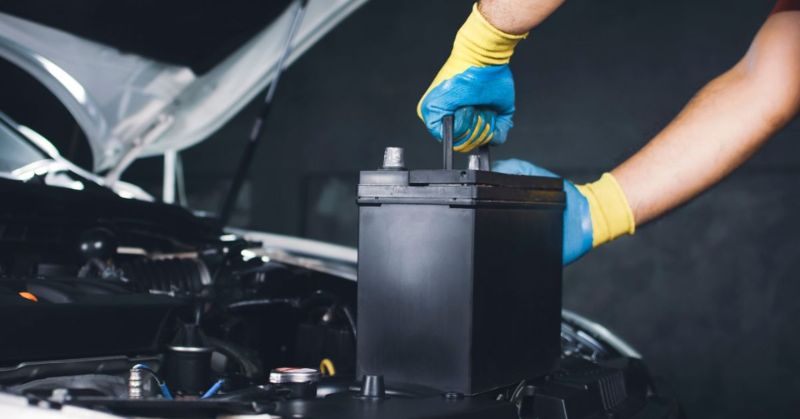How Many Cold Cranking Amps Do I Need for Cold Weather?
Do you live in a cold place? You must have experienced the car not starting when going to the office on a freezing morning. It becomes frustrating, especially when you have to attend an urgent and important meeting. This is where the term "cold cranking amps" comes in. This term is often misunderstood. For example, many people think that a low CCA rating means a bad car battery, a higher CCA is beneficial in a cold environment, and a higher CCA battery is unsafe.
If you are wondering what do cold cranking amps measure and whether they really matter, you've come to the right place. This article explains what cold cranking amps are, how cold weather impacts your car battery, and how many cold cranking amps do I need. Moreover, you will also see the factors that affect CCA needs and how you can select the right battery for your car.
What are cold cranking amps (CCA)?
Are you wondering, "What does cold cranking amps mean?" Well, the number of amps your car battery can deliver at -18 degrees Celsius or 0 degrees Fahrenheit for half a minute (or 30 seconds), thereby maintaining a voltage of at least 7.2V, are called cold cranking amps or CCA.
There should be specific standards to help buyers understand which battery will perfectly meet their vehicle power needs. This is where the battery's CCA rating plays its role. The primary function of the car's battery is to start your vehicle's engine. It continues to provide a sufficient voltage level in parallel to cranking or rotating the crankshaft until the car's engine maintains the desired rotation.
To rotate the crankshaft, the battery needs a high current discharge for a short time. Simply put, the amount of power a battery should deliver to start a vehicle in cold weather is known as cold cranking amps or CCA. In other words, you can say that CCA provides a battery with extra strength to start a car in cold weather compared to what it does in hot weather.

How does cold weather impact your battery?
Are you wondering, "Why do you need to know the battery's CCA rating"? Well, it is because of the impact of cold weather on your vehicle's battery.
As you know, batteries deliver the desired amount of power due to chemical reactions occurring within their structure. These chemical reactions slow down when the batteries are placed in a low-temperature atmosphere.
Therefore, if you live in cold weather or are planning to visit a similar place, the chemical reactions in your car battery will not occur at the speed they do in warm weather. Slow reactions allow batteries to produce less electric current.
Moreover, when the engine oil is cold, it becomes thicker and struggles to pass through the engine's block. In the cold environment, the diesel fuel gels in diesel engines, making it hard for them to start properly.
Slow chemical reactions within the batteries and the thickness of engine oil create increased resistance and make it harder for batteries to provide enough power required to start a vehicle's engine. The temperature ranges and their effects on battery performance are as follows.
- Ideal temperature: The battery performs well at 80°F (26.7°C).
- Cold temperature: The battery capacity decreases with a drop in the temperature. The capacity drops to 50% at -22°F (-30°C).
- High temperature: The temperature above 122°F (50°C) shortens the battery life.

How many cold cranking amps do I need for my vehicle?
When determining the CCA requirements for your car, two factors come into play: vehicle type and engine size. According to the standard recommendation, a car battery should have at least 1 CCA/cubic inch of engine displacement.
In the case of diesel engines, the battery should have 2 CCAs because larger engines or diesel vehicles need batteries with higher CCA ratings. As you know, the pistons move up and down in the cylinder. This movement produces air. The measurement of the combined displaced volume of that air is called engine displacement.
Don't worry about estimating correct CCAs yourself, as you don't need to do this. With each engine and vehicle model, the manufacturers provide CCA requirements. All you need to do is visit the manufacturer's website or check the owner's manual and restrict to the provided requirements.
CCA requirements are more important when you buy a used vehicle. The reason behind this fact is that the previous owner may have replaced the car's battery with one that does not perfectly meet your car's standards. In that case, when you plan to replace the existing battery with the new one, remember to ensure that it at least meets or exceeds the specifications mentioned in the owner's manual or on the manufacturer's website.
The general CCA ratings for different vehicles (small to large) are as follows.
- Small cars: 350-400 CCA
- Medium cars: 400-600 CCA
- Large vehicles and trucks: 600-900 CCA

Factors that influence CCA requirements
Different factors that help you determine the required CCA for your car are as follows.
- Vehicle type: Different vehicle types need different amounts of power to start. For example, the starting power of a large truck and a small sedan is different. Similarly, marine vessels, golf carts, and ATVs have different CCA requirements.
- Engine size: Bigger engines need more power to start properly. Similarly, higher CCA ratings are required for engines with more cylinders, as high power is needed to rotate the engine's crankshaft.
- Battery age: As your car battery ages, it will not be able to deliver high power. The older battery may need higher CCA ratings to compensate for the loss. Moreover, a well-maintained battery can offer the desired power for a longer period. Therefore, make a habit of regular maintenance.
- Climate: Batteries with higher CCA ratings perform better in cold climates. The cold weather makes it difficult for the car battery to deliver the amount of power required to start an engine.
What do cold cranking amps measure?
Dive deeper into the technical aspects of CCA measurement. Explain the testing process and standards used by battery manufacturers. Clarify why CCA is particularly relevant for vehicle starting performance.
As stated earlier, cold cranking amps measure the ability of a car battery to start a vehicle's engine in a cold environment. Knowing the right CCA requirements is essential for everyone who lives in a cold climate or visits spots frequently where the temperature is below freezing. It ensures that the vehicle starts smoothly in low-temperature conditions.
According to the Society of Automotive Engineers (SAE), the temperature at which EN and CCA tests are performed is -17.8 degrees Celsius. The EN test is more strict than the cold cranking amps test because it requires the car battery to perform at the highest level for more time. This is the reason the CCA rating of the battery is higher than the EN rating.
Cold cranking amps are relevant for the starting performance of a car because they measure the ability of the battery to start the engine at a freezing temperature.
How to choose the right battery for your vehicle?
There are different methods to check the CCA requirements for your vehicle. Let's look at a few.
- Check the owner's manual: The manufacturers usually mention a particular CCA rating for the car based on its design and engine size. To find this information, you can check your manufacturer's manual.
- Check the battery label: The minimum CCA requirement of the car is also mentioned on the battery label. It is another way to get an idea of which battery to choose for your vehicle.
- Consider the weather: If you are a resident of an area where the temperature stays below freezing, select the battery with the higher CCA rating. Doing this will make sure that your vehicle starts reliably in cold weather.
Considering the engine size is equally important when choosing the right battery. Generally, it is recommended to select a battery with a higher CCA rating than the minimum recommended value.

Do cold cranking amps really matter?
The importance of CCA ratings can be different in different driving conditions and climates. Remember to consider this factor when choosing the battery for your car.
Cold cranking amps may not matter for people living in warm environments where temperatures do not go below freezing. In comparison, CCA ratings matter a lot in low-temperature environments. Since cold temperature slows down the chemical reactions within the batteries and thickens the engine's fluid, it is crucial to check CCA ratings before you purchase a battery for your vehicle.
If you want to buy a battery for trucks or cars that are frequently used in warm temperatures, you can simply ignore the CCA rating. Instead, you must focus on the reverse capacity of the battery.
If you do not meet the minimum CCA requirements recommended by the manufacturer, your vehicle won't be able to start in the cold climate and will negatively impact the battery's performance and life.
Suppose you plan to buy batteries for deep-cycle storage or long-term usage. In that case, cold cranking amps will not matter at all. The CCA rating becomes irrelevant if you don't need a quick burst of energy from the battery.
CCA ratings help you determine how reliable the car battery is. Similarly, considering the brand, size, and capacity is also important to ensure the optimal performance of your vehicle. If you need reliable and long-lasting batteries for your vehicle, remember to explore the unmatched collection at Renogy.
Conclusion
If you're searching for how many cold cranking amps do I need for a vehicle, it depends on engine size, vehicle type, and climate. Larger vehicles need higher CCA ratings. If you live in a warm environment, you don't need to consider the CCA rating. However, it matters a lot in the cold climate.
To find the correct CCA requirements for your car, remember to check the owner's manual or visit the manufacturer's website. You can also check the battery label.
Frequently asked questions
Is higher cold cranking amps better?
Higher cold cranking amps provide more power to start vehicles in cold climates. Therefore, they are considered more reliable and better.
Is 800 cold cranking amps good?
Yes, 800 is a good CCA rating for many cars, especially those that are driven in low-temperature environments.
How many CCAs do I need for a V8?
It actually depends on the engine's displacement. However, the battery for V8 should have one amp per cubic inch of displacement. You should never select a battery with less than 550 CCA rating for V8.











